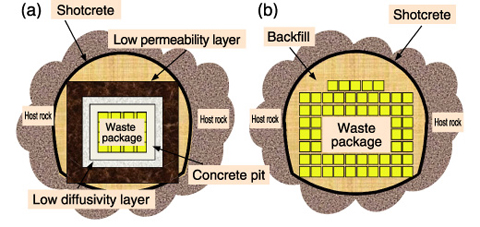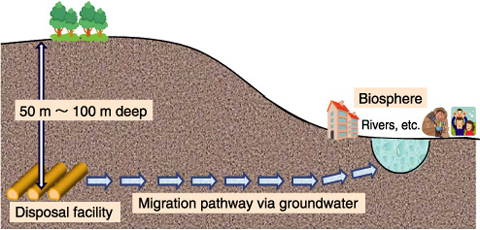
Fig.11-4 Disposal cavern concept

Fig.11-5 “Groundwater scenario” concept
Table 11-1 Scenario development and parameter set-up for safety assessment
Radioactive wastes are generated by various activities at the nuclear facilities of JAEA. Safe disposal of these radioactive wastes is an important issue for unimpeded advancement of our activity. We are carrying out safety assessments to confirm the safety of disposal of uranium waste over a long period of time.
Because the half-life of uranium is extremely long, the engineered barriers (low diffusivity layer, low permeability layer, etc.) cannot maintain their confinement function over a long period of time. We therefore devised a reasonable disposal cavern without making use of them (Fig.11-4).
The object of our study is the assessment of public exposure when radionuclides in the disposal facility migrate to the surface water via groundwater (Fig.11-5), when the disposal facility comes close to the ground surface due to uplift/erosion, and so on.
In the safety assessment, it is important to confirm that the public is safe from exposure over a long period of time. Natural events, such as climate change and geomorphological change, are assumed, and it is necessary to predict what will change, and how and when its state will change in the future, based on scientific data. Table 11-1 shows an example of arranging the assessment scenarios (a number of natural events), the related change events, and parameter changes in the safety assessment. The parameters are referenced to data supporting scientific knowledge because a concrete disposal site has not been fixed at present.
Under the conditions mentioned above, we carried out development of assessment scenarios that were assumed to correspond to the groundwater scenario, and performed parameter setting and safety assessment. As a result, we confirmed that the exposure dose to the public was very low even when various event changes were considered.
We assume that in the future it will be important to perform more detailed safety assessments considering specific parameters, the rate of change in the events, and so on.